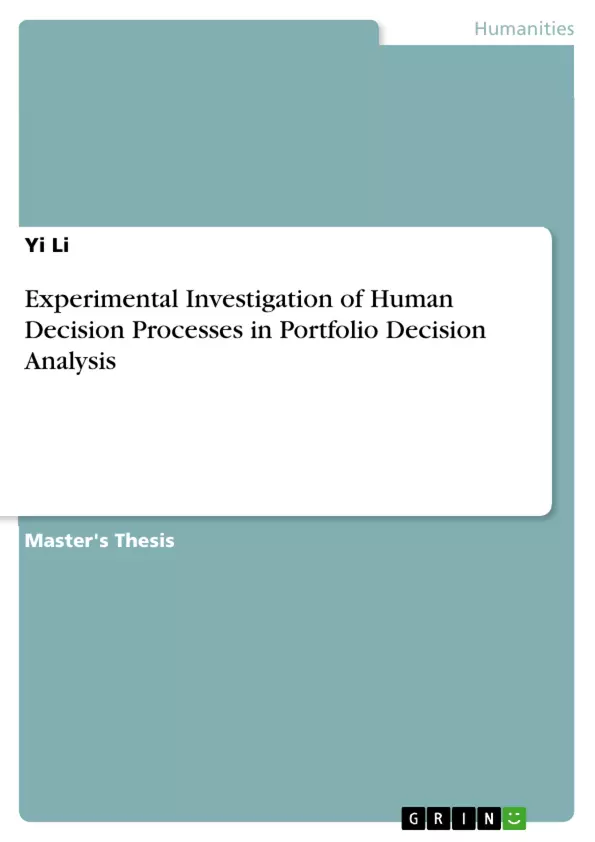Till now operations management mainly dealt with finding appropriate models to facilitate decision making processes, but these theoretical concepts did not always help to deal with actual processes in practice. Thus the understanding of human behaviour becomes more and more important. Furthermore the behavioural aspect of the decision making process plays a big role, as everyone of us would face resource allocation situations or portfolio decisions and people always do not make optimal decisions as mathematical models would do, but rather a completely another way often based on heuristics. Therefore it is interesting to investigate how people tackle such decision making situations intuitively and which cognitive strategies they follow thereby.
This work aims to give a detailed overview about the relating literatures at first. Then decision making processes in portfolio decision situations are experimentally investigated regarding to behavioural aspects, in this case concerning knapsack problems, with the application of the methodology verbal protocol analysis. Concrete heuristics which subjects were following during the decision process could be identified and classified under the terms of certain criterions for further analysis. Hereby verbal protocol analysis helped to collect good and applicable data for determining specific behaviour of people in portfolio decision processes.
Inhaltsverzeichnis (Table of Contents)
- Introduction
- Literature Review
- Financial Portfolio Optimization
- Resource Allocation
- Decision Analysis
- Theory of the Experimental Framework
- Knapsack Optimization Problem
- Laboratory Experiment
- Verbal Protocol Analysis
- Methodology
- Experimental Design
- Task
- Participants
- Experimental Procedure
- Encoding Process
- Analyzing Process
- Experimental Design
- Results
- Optimality and Iteration
- Optimality a within heuristic groups
- Optimality a regarding type of calculation
- Optimality a regarding verbalizing effects
- Optimality a with or without overview
- Iterating steps
- Heuristics and Metrics
- Heuristics
- RRS2 and DRP2
- Rank-Range-Part (RRS2) and Data-Range-Part (DRP2) with Updating
- Outcome
- ARS2
- Behavioural Aspects
- Optimality and Iteration
Zielsetzung und Themenschwerpunkte (Objectives and Key Themes)
This research aims to investigate human decision processes in portfolio decision analysis, specifically focusing on the behavioral aspects of knapsack problems. The study aims to bridge the gap between theoretical operations management models and real-world decision-making practices by understanding how individuals intuitively approach resource allocation situations.
- Investigating human decision processes in portfolio decision analysis
- Analyzing behavioral aspects of knapsack problems
- Understanding cognitive strategies employed by individuals in resource allocation situations
- Exploring the connection between theoretical models and practical decision-making
- Identifying and classifying heuristics used in portfolio decision processes
Zusammenfassung der Kapitel (Chapter Summaries)
The research begins with a comprehensive literature review exploring financial portfolio optimization, resource allocation, and decision analysis. This provides a foundational understanding of existing theories and approaches. Chapter 3 introduces the theoretical framework for the experimental study, including a detailed explanation of the knapsack optimization problem, the laboratory experiment design, and the method of verbal protocol analysis. The methodology chapter delves into the experimental design, participant selection, and the procedures employed during the study. The focus is on collecting detailed data through verbal protocol analysis to analyze the cognitive strategies utilized by participants. Chapter 5 presents the findings of the study, analyzing the optimality of participant choices, the heuristics employed, and the behavioral aspects observed. The analysis explores factors such as type of calculation, verbalization effects, and the presence of an overview.
Schlüsselwörter (Keywords)
The primary focus of this research is on human decision processes, portfolio decision analysis, knapsack problems, resource allocation, behavioral aspects, cognitive strategies, heuristics, verbal protocol analysis, and experimental methodology. This research explores the gap between theoretical models and real-world decision-making practices, seeking to understand how individuals approach complex resource allocation situations in a more intuitive and heuristic manner.
- Arbeit zitieren
- Yi Li (Autor:in), 2013, Experimental Investigation of Human Decision Processes in Portfolio Decision Analysis, München, GRIN Verlag, https://www.grin.com/document/310819



